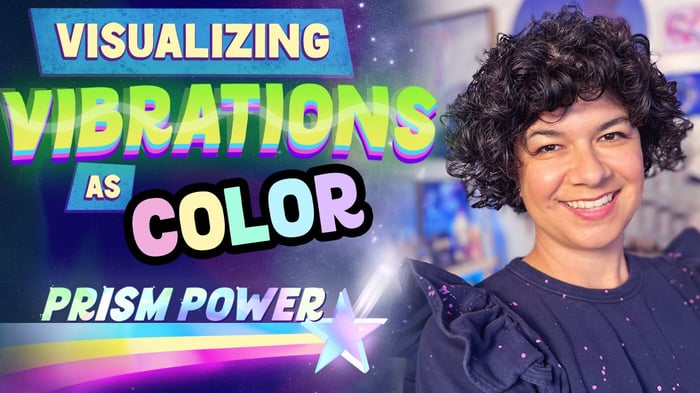
The Energy of Color | Prism Power
This is a transcript of Ep.02 of Prism Power entitled "The Energy of Color." View the full episode below.
In this episode, we’re going to dive into the science behind colors and explain why and how we are able to perceive different colors.
Our experience of color is based on our brain’s interpretation of wavelengths of light. So in essence color is energy, with each color producing its own vibration.
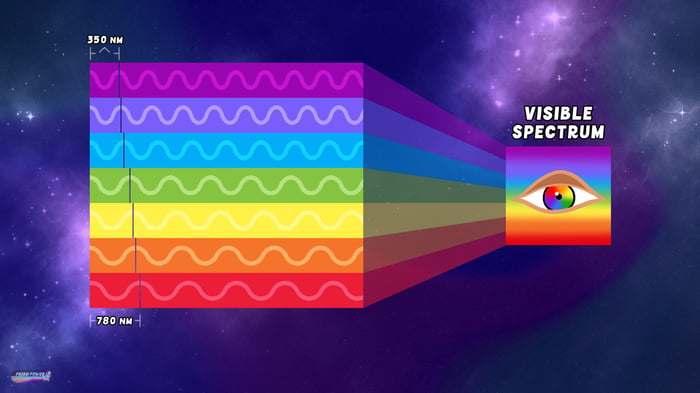 The Visible Spectrum of Humans.
The Visible Spectrum of Humans.The visible spectrum of humans ranges from about 350 to 780 nanometers. The latter represents long wavelengths of color that produce a deep red color. While the shortest wavelengths of color that we can perceive, produce a violet color. Generally speaking, the longer the wavelength, the easier it is for our eyes to perceive it. That is why red is such an eye-catching hue–because the wavelength it produces is one of the easiest for our brains to interpret along with other warm colors like orange and yellow. It’s also easier for us to decipher more colors within the warmer end of the visible spectrum than the cooler end of the spectrum. And I’ll explain why in a bit.
For now, let’s talk about colors that are not encompassed and shown here within this visible spectrum. For example, you may notice that colors like pink, brown and magenta aren’t included in this spectrum, but our brains are still able to distinguish them.
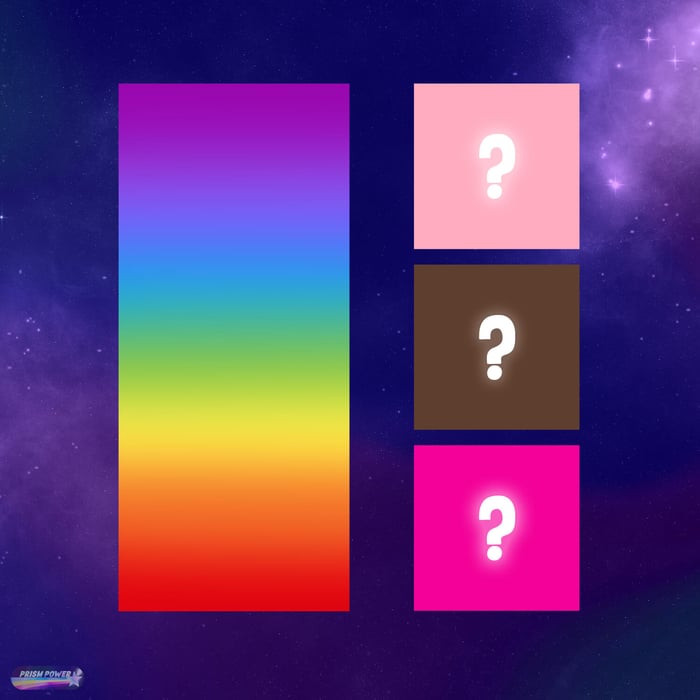 On the right are colors we can see, but that are not displayed within the visible spectrum.
On the right are colors we can see, but that are not displayed within the visible spectrum.Why is that? Well, that is because these colors are produced through a mixture of multiple wavelengths. And this is similar to how neutral colors work as well. With white consisting of all the colors or wavelengths within the visible spectrum, and black representing the absence of all color. This unique quality to the color white is best illustrated with the help of a prism.
 A prism refracting white light.
A prism refracting white light.A prism is a piece of glass or other transparent material that is cut in precise angles in order to create flat faces along its surface, like you see here. When light passes through a prism, the different wavelengths of color that are encompassed within white light, become refracted, resulting in a rainbow effect. So in other words, prisms allow us to actually see all the different colors that exist within the color white.
For this episode, I really want us to focus in on the energetic properties of color so therefore, I don’t want to complicate this discussion too much by talking about subtractive and additive color mixing which has to deal with mixing paint colors versus colors of light.
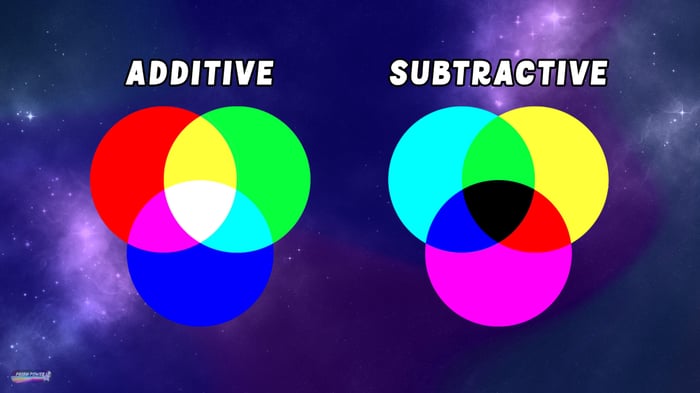 Additive and Subtractive Color Mixing.
Additive and Subtractive Color Mixing.But I’ll only mention it briefly here by saying that white light consists of all the colors of the rainbow because it is the result of additive color mixing. Since if you were to mix primary and secondary paint pigments together, you would definitely not get the color white. Instead, you would get a color that is close to black, which is why that form of color mixing is called subtractive because what you end up with is a color that does not have a wavelength and therefore, is the absence of color. Which, when you think about it, makes you wonder why we even call black a “color.”
Now let’s touch on the biological mechanisms in our eyes that help us to interpret different wavelengths. The retinas in our eyes contain two types of photoreceptors–rods and cones.
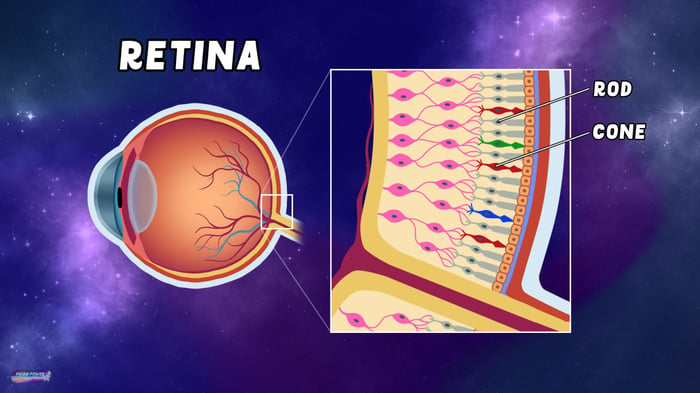 The inside of our retinas contain rods and three types of cones.
The inside of our retinas contain rods and three types of cones.Our rods help us to perceive black, white and grey values. But it’s our cones that we rely on to detect color. There are three types of cones in the human eye that are sensitive to short, medium and long wavelengths. With the help of these three different cones, we are able to distinguish an estimated 10 million colors! And the reason why it’s easier for us to perceive warm colors like red is because two thirds of our cones are of the longer variety meaning we inherently have less cones that detect shorter wavelengths, which then makes it harder for us to distinguish between colors on the cooler end of the spectrum. You might be wondering here what causes color blindness in some individuals. Well, this has to do with how well the 3 different types of cones are operating in a person's eyes.
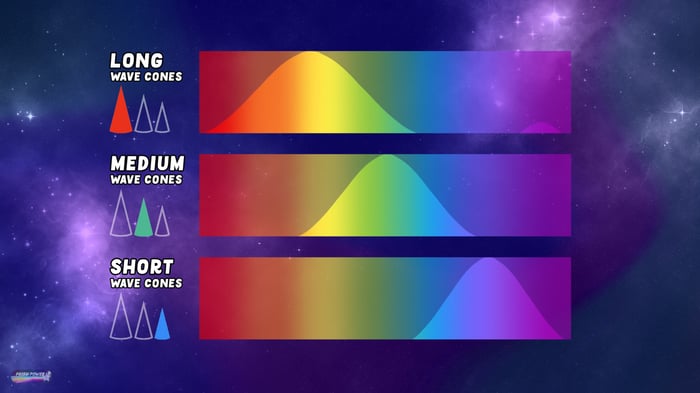 The three cones types and the range of colors they each help us see.If even one of the three types of cones I described are not working properly or are possibly absent from someone’s eye structure, then they will be blind to certain types of colors depending on which cone is not performing as expected. Since without the 3 functioning cone types that help to detect short, medium and long wavelengths, then there will be a certain wavelength associated with a specific color that an individual with color blindness will have difficulty perceiving.
The three cones types and the range of colors they each help us see.If even one of the three types of cones I described are not working properly or are possibly absent from someone’s eye structure, then they will be blind to certain types of colors depending on which cone is not performing as expected. Since without the 3 functioning cone types that help to detect short, medium and long wavelengths, then there will be a certain wavelength associated with a specific color that an individual with color blindness will have difficulty perceiving. I’m going to start getting philosophical on you here and say that in reality, everyone has a form of color blindness because we know – scientists have measured – wavelengths that exist outside our visible spectrum.
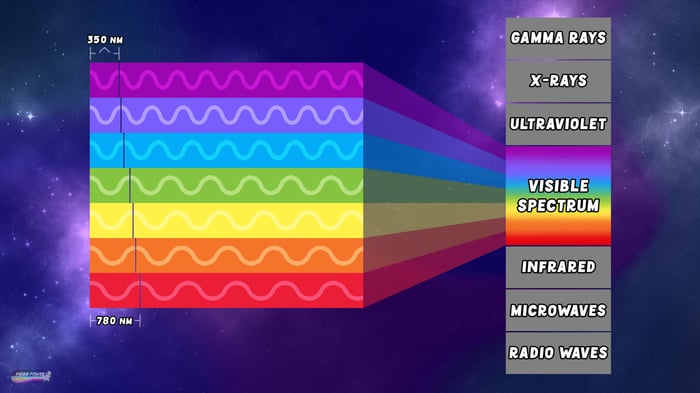 Wavelengths that exist outside of our visible spectrum.
Wavelengths that exist outside of our visible spectrum.Now remember how I just said colors that produce longer wavelengths are generally easier for us to identify and perceive than shorter wavelengths? Well it’s on the shorter end of the spectrum beyond the color violet, where even more colors exist. This is what we call ultraviolet or UV light. We as humans do not have the physiological ability to see this end of the spectrum with our naked eyes but other creatures do. Bees and other insects can see wavelengths that range from about 300 to 650 nanometers.
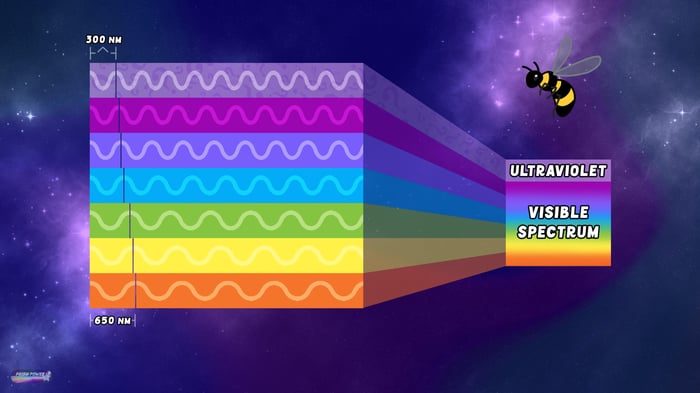 The Visual Spectrum of Bees
The Visual Spectrum of BeesSo they actually can’t see deep red but they can see colors that lie just beyond violet. The reason bees in particular need to be able to see ultraviolet colors is because flowers have distinctive ultraviolet color patterns that are invisible to us, but incredibly eye-catching to bees. So think about that, it is because of color that we can verify that there are qualities about our world that exist outside our physical ability to perceive them. And in some ways violet represents the liminal edge of where our visual perception ends and just beyond which, we know another form of reality exists. I think that’s probably why purple is instinctively one of my favorite colors to work with because I really enjoy exploring the subconscious and mysterious concepts in my paintings. And it’s also the color purple that is associated with your third eye chakra or intuition.
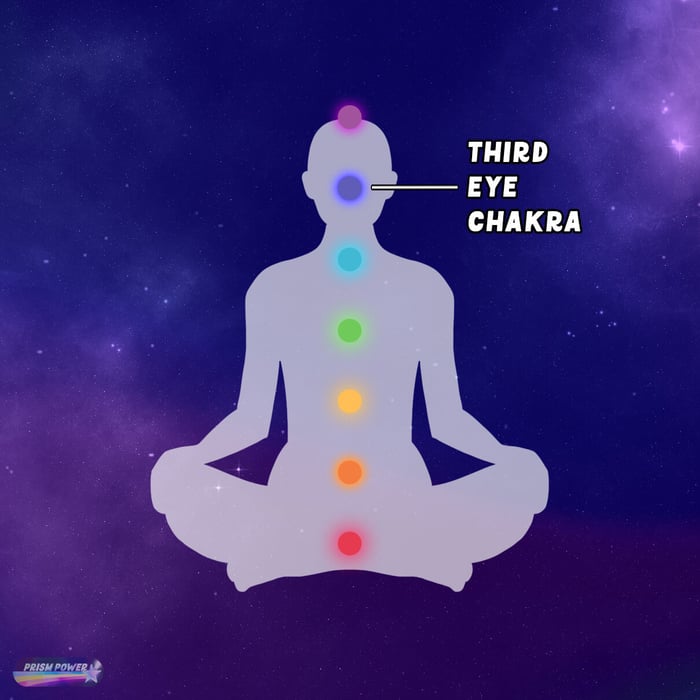 Third Eye Chakra
Third Eye ChakraI’m going to leave you with a fascinating thought when it comes to how we perceive the world through color but to do that, I first need to explain to you how rainbows are made. Rainbows are a purely visual phenomenon since you can’t necessarily touch or hear a rainbow. Remember how prisms help to refract light so that we can see all the colors that exist within it? Well this same form of refraction happens with rain drops.
 How rainbows form within our sense of vision
How rainbows form within our sense of visionWhen water is in the atmosphere it causes sunlight to refract which then produces a rainbow effect within our sense of vision. As you recall, not every person or every creature has the same types of cones in their retinas that allows them to see the different wavelengths of color in a rainbow the same way. And for an animal who has no cones, well they would be incapable of perceiving a rainbow at all. Therefore, rainbows are a phenomenon that are dependent on an observer in order to make them real. So if you think about it, we aren’t just passive observers of rainbows, we actually help to create them.
 A Supernumerary Rainbow.
A Supernumerary Rainbow.
I hope this information helps to give you a deeper appreciation and a better understanding of the multiple levels of meaning that color fills our lives with. See you next time on Prism Power.
